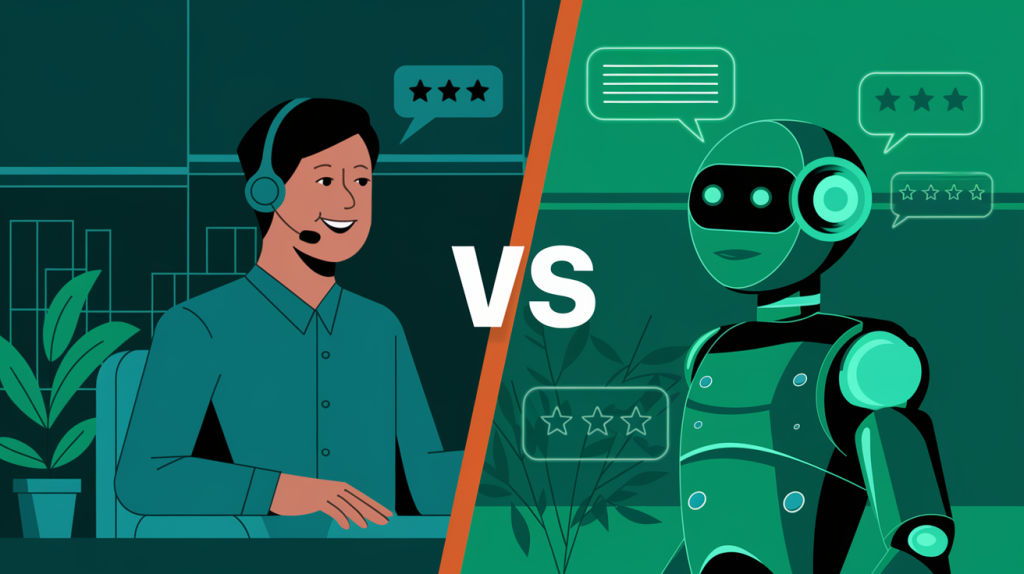Human vs. Chat: The Ultimate Support Showdown

Imagine you’re facing an issue with a product or service, and you need help. You reach out to customer support. But here’s the catch: you’re not sure whether you’ll be talking to a human or a chatbot. According to recent studies, 67% of customers prefer speaking with a human agent for complex issues, but 55% are comfortable with chatbots for simple queries. The debate between human support and chatbot assistance is more relevant than ever.
So, what’s the truth? Are chatbots the future of customer service, or is the human touch irreplaceable? In this showdown, we’ll explore the strengths and weaknesses of both human agents and chatbots in providing support. Let’s break it down.
The Case for Human Support
When it comes to customer support, humans have some serious advantages. Here’s why many customers still prefer the personal touch:
- Emotional Intelligence: Humans can pick up on subtle emotions and adjust their responses accordingly. If you’re frustrated or upset, a human agent can empathize with you, something a chatbot simply can’t do.
- Problem-Solving: Human agents have the ability to think critically and solve complex problems. They can analyze a situation from multiple angles and offer personalized solutions.
- Flexibility: Humans are not limited to pre-programmed scripts. They can think outside the box, offering creative solutions to unique problems that a chatbot might miss.
- Building Relationships: Customers feel more valued when they interact with a human who remembers them or their previous interactions. This personal connection can build long-term loyalty.
While human agents excel at providing that personal touch, they come with some downsides, especially when it comes to speed and efficiency.
The Case for Chatbots
Chatbots, powered by artificial intelligence, are taking the customer service world by storm. But do they truly live up to the hype? Let’s see what makes them stand out:
- Speed and Efficiency: Chatbots can handle multiple inquiries at once, delivering instant responses to customers. Whether it’s answering FAQs or guiding customers through simple processes, chatbots excel in speed.
- 24/7 Availability: Unlike humans, chatbots don’t need breaks. They’re available around the clock, ready to assist customers at any time of day or night.
- Cost-Effective: Since chatbots can handle high volumes of repetitive inquiries, they save businesses money by reducing the need for a large customer support team.
- Consistency: Chatbots never get tired, and their responses remain consistent, ensuring that all customers get the same level of service regardless of time or workload.
While chatbots are impressive in many ways, they do have their limitations.
The Drawbacks of Chatbots
Though chatbots bring a lot of advantages to the table, they aren’t without their flaws:
- Limited Understanding: Chatbots often struggle with complex queries that go beyond their programmed responses. They can misinterpret questions, leading to frustration.
- Lack of Empathy: While chatbots can provide quick answers, they can’t offer emotional support or truly understand customer frustration, which is critical in certain situations.
- Frustration with Escalation: If a chatbot can’t resolve an issue, it often transfers the customer to a human agent. However, this transition isn’t always smooth, and customers may feel like they’re starting over from scratch.
When to Choose Human Support vs. Chatbot
So, when should businesses use human agents, and when is a chatbot the best option? It depends on the situation. Here’s a quick guide:
Use Human Support for:
- Complex or unique problems: If a customer has an issue that requires creative thinking or deep knowledge, a human agent is a must.
- Emotional support: When a customer is frustrated or upset, human empathy is irreplaceable.
- Personalized assistance: For customers who need tailored solutions, human agents excel at providing a custom approach.
Use Chatbots for:
- Simple, repetitive inquiries: For basic tasks like checking order status or answering FAQs, chatbots are perfect.
- 24/7 availability: If your business needs to provide round-the-clock support, chatbots ensure that help is always available.
- Speedy resolutions: For simple queries that don’t require much explanation, chatbots can deliver instant answers.
Can Humans and Chatbots Work Together?
The ultimate customer support setup isn’t choosing between humans or chatbots—it’s integrating both. Many businesses are already using a hybrid model, where chatbots handle simple tasks and direct customers to human agents when necessary. This ensures fast responses while maintaining the personal touch when required.
For example:
- Chatbot for initial inquiries: A chatbot can answer general questions like store hours, product details, or order tracking.
- Human for complex issues: If the chatbot cannot resolve the issue, it transfers the customer to a live agent, who picks up the conversation seamlessly.
Conclusion
While both humans and chatbots have their pros and cons, the future of customer support lies in combining the best of both worlds. Humans offer empathy, problem-solving, and personalized service, while chatbots provide efficiency, availability, and consistency. By integrating both into your support strategy, you can ensure your customers get the best possible experience—whether they need a quick answer or a more complex solution.In the end, it’s not about replacing one with the other; it’s about using each for what they do best. So, the next time you reach out for support, remember: it’s not a competition—it’s a collaboration.